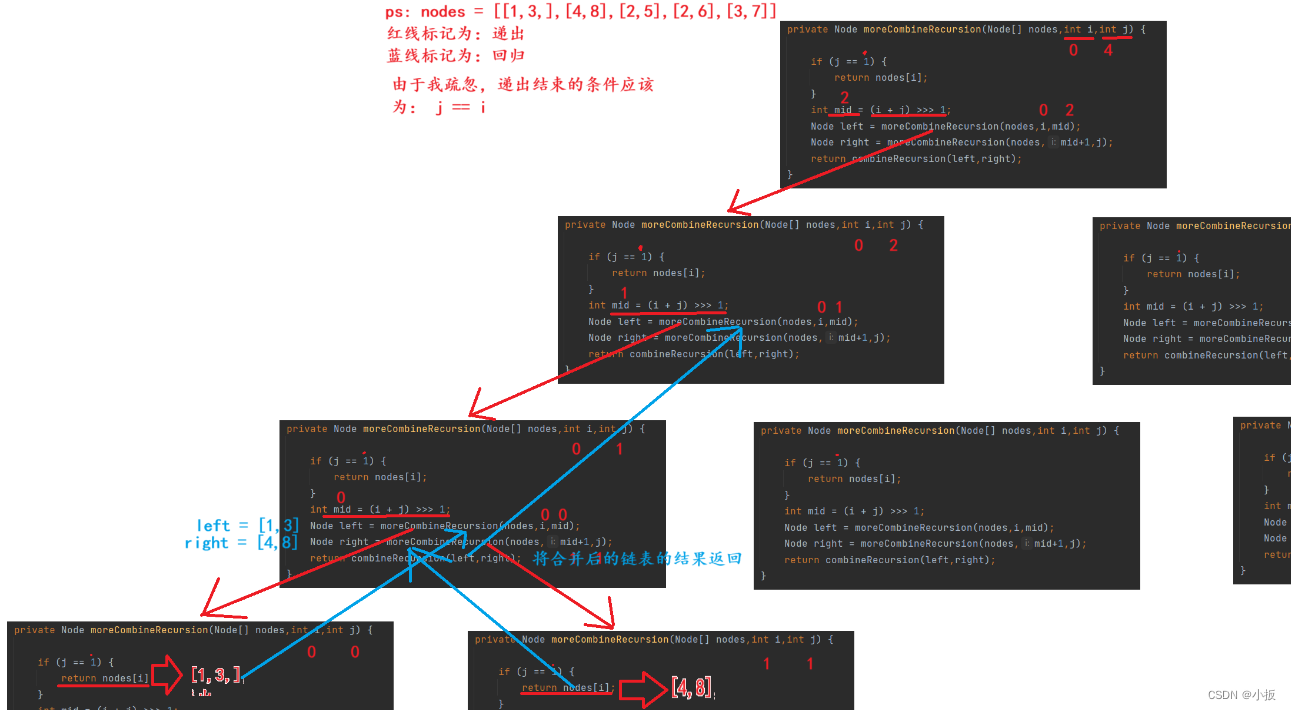🔥博客主页: 【小扳_-CSDN博客】**
❤感谢大家点赞👍收藏⭐评论✍**


1.0 链表的说明
**为了更好的讲解本篇当中的两种经典算法,先创建一个带哨兵的链表。链表是一种常见的数据结构,用于存储一系列元素。链表由一系列节点组成,每个节点包含一个数据元素和一个指向下一个节点的指针。**
代码如下:
import java.util.Iterator; public class List implements Iterable<Integer>{ private Node sentry; static class Node { public int value; public Node next; public Node(int value, Node next) { this.value = value; this.next = next; } } public List() { sentry = new Node(-1,null); } //头插节点 public void addFirst(int value) { sentry.next = new Node(value,sentry.next); } //尾插节点 public void addLast( int value) { Node temp = sentry; while (temp.next != null) { temp = temp.next; } temp.next = new Node(value,null); } //重写迭代器 @Override public Iterator<Integer> iterator() { return new Iterator<Integer>() { Node p = sentry.next; @Override public boolean hasNext() { return p != null; } @Override public Integer next() { int value = p.value; p = p.next; return value; } }; } }**简单讲解一下,创建了一个链表类,该类中包含一个静态内部类,即节点类,还实现了一个基本的方法:头插节点、尾插节点、重写了迭代器等等。**需要了解的小伙伴可以点击该链接:【Java 数据结构篇-实现单链表核心API-CSDN博客】
2.0 有序链表去重的实现方式
** 在此之前,需要分为两个方向:**
** 一、需要保留重复值的节点**
** 使用递归来实现有序链表的去重、使用双指针来实现有序链表的去重。**
** 二、不需要保留重复值的节点**
** 使用递归来实现有序链表的去重、使用三指针来实现有序链表的去重。**
2.1 有序链表去重(保留重复的节点) - 使用递归来实现
**具体思路:先来考虑终止递出的条件为:p == null 或者 p.next == null ,对于 p == null 情况,当该链表为空链表时,直接返回 null ,对于 p.next == null 情况,当递出到最后只剩一个时,也没有必要继续下去了,不会再有重复的值的节点了。再来考虑递出的具体过程:当 p.value == p.next.value 的情况,就该忽略该节点,则需要返回下一个节点;当 p.value != p.next.value 的情况,就需要返回该节点,但是在返回之前,需要对 p.next 该节点的指向进行重整。**
代码如下:
//去重方法一(保留):递归 public List removeRecursion(List list) { Node sentry1 = list.sentry; sentry = recursion1(sentry1); return list; } private Node recursion1(Node p) { if (p == null || p.next == null) { return p; } if (p.value == p.next.value) { return recursion1(p.next); }else { p.next = recursion1(p.next); return p; } }** 需要注意的是,先得判断链表对象是否为 null ,不然会空指针异常。**
2.2 有序链表去重(保留重复的节点) - 使用双指针来实现
**具体思路:定义两个指针 n1 与 n2 ,对于 n1 来说:n1 一开始指向头节点,假如指向哨兵节点时,那么后续就会掺入了哨兵节点的值来比较,因此,n1 一开始时需要指向头节点。对于 n2 来说,n2 = n1.next ,也就是 n2 在 n1 指向的节点的前一个节点。接下来:当 n1.value == n2.value 时,则将 n1.next = n2.next ;当 n1.value != n2.value 时,则 n1 = n1.next 。 **
** 循环的条件为:(n2 = n1.next) != null 。**
代码如下:
//去重方法二(保留):双指针 public List removeDoublePointer(List list) { if (list == null) { return null; } //少于两个节点,不存在重复的值 if (list.sentry.next == null || list.sentry.next.next == null) { return null; } Node n1 = list.sentry.next; Node n2; while ((n2 = n1.next) != null) { if (n2.value == n1.value) { n1.next = n2.next; }else { n1 = n1.next; } } return list; }**需要注意的是,先得判断对象是否为 null ;还有一种情况,当节点少于两个时,不存在重复的值的节点。**
2.3 有序链表去重(不保留重复的节点) - 使用递归来实现
**具体思路:先来考虑递出的终止条件为:当 p == null 或者 p.next == null 的情况时,直接返回 p 该节点,因为当 p.next == null 时,不存在有两个重复值的节点,因此就没有必要再继续递归下去了。再来考虑递出的两种情况:当 p.value != p.next.value 时,没有重复,则返回当前节点 p ,但是在此之前,需要对 p.next 重新赋值,即重新调整 p.next 的指向;当 p.value == p.next.vaule 时,存在重复,则将该值的节点全部找出来,直到找到最后一个节点。循环的条件为: p.value == p.next.value ,循环结束后,得到的 p 就是最后一个重复值的节点,因为不需要这个节点,则返回下一个节点。**
代码如下:
//去重方法一(不保留):递归 public List removeRepeat(List list) { Node temp = list.sentry; sentry = recursion(temp); return list; } public Node recursion(Node p) { if (p == null || p.next == null) { return p; } if (p.value != p.next.value) { p.next = recursion(p.next); return p; }else { while (p.value == p.next.value) { p = p.next; } return recursion(p.next); } }**同样的,也需要先判断该对象是否为 null ,否则容易报异常。**
2.4 有序链表去重(不保留重复的节点) - 使用三指针来实现
**具体思路:先定义三个指针,对于 p1 来说: 一开始时指向哨兵节点,假如不实现哨兵节点,则删除不了当链表中前几个为重复值的节点(比如:1->1->1->2->null) ,因此,需要实现哨兵来完成该需求;对与 p2 来说:一开始时指向头节点,即 p1.next;对于 p3 来说:一开始时指向头节点的下一个节点,即 p2.next 。接下来,对于循环的两种过程来分析:当 p2.value == p3.value 时,需要接着找到两个节点的值不相等的时候,所以内层循环条件为:p2.value == p3.value 且 p3 != null,这里需要特别注意的是,千万不能丢了 p3 != null 的限制条件。跳出内层循环是,就可能意味着找到了,则将 p1.next = p3 ;当 p2.value != p3.value 时,直接 p1 = p1.next 即可。外层循环的条件为:((p2 = p1.next) != null 且 (p3 = p2.next) != null)**
代码如下:
//去重方法二(不保留):三指针 public List removeThreePointer(List list) { if (list == null) { return null; } Node n1 = list.sentry; Node n2 ; Node n3 ; while ((n2 = n1.next) != null && (n3 = n2.next) != null) { if (n2.value == n3.value) { while (n3 != null && n2.value == n3.value) { n3 = n3.next; } n1.next = n3; }else { n1 = n1.next; } } return list; }**这里有个小技巧,对与 p2、p3 来说,不着急赋值,在判断条件的时候再进行赋值,可以简略代码量,提高可读性。**
3.0 合并升序链表
** 分为两种情况:**
** 一、合并两个升序链表**
** 使用迭代法实现合并链表、使用递归实现合并链表**
** 二、合并多个升序链表**
** 合并多个升序链表就是一个个合并两个升序链表的情况,用递归来实现**
3.1 合并升序链表(两个链表) - 迭代法
**具体思路:对于两个链表合并来说,在各自的链表中分别定义一个指针,分别指向各自的头节点。合并一条新的链表,定义一个指针指向哨兵节点。**
代码如下:
//合并升序链表 public static List combinedList(List l1,List l2) { if (l1 == null && l2 == null) { return null; } else if (l1 == null) { return l2; } else if (l2 == null) { return l1; } List newList = new List(); Node node1 = l1.sentry.next; Node node2 = l2.sentry.next; Node p = newList.sentry; while (node1 != null && node2 != null) { if (node1.value < node2.value) { p.next = node1; node1 = node1.next; }else { p.next = node2; node2 = node2.next; } p = p.next; } if (node1 != null) { p.next = node1; } if (node2 != null) { p.next = node2; } return newList; }
3.2 合并升序链表(两个链表) - 递归法
**具体思路:先来考虑递出的终止条件为:当 p1 == null 时,则直接返回 p2;当 p2 == null 时,则直接返回 p1。再来考虑递出的过程:当 p1.value < p2.value 时,返回的节点为 p1 节点,在返回节点之前,需要将 p1.next 对该节点的重新调整指向下一个节点;当 p1.value >= p2.value 时,返回的节点为 p2 节点,同理,在返回该节点之前,需要将 p2.next 对该节点的重新调整指向下一个节点。**
代码如下:
private Node combineRecursion(Node p1, Node p2) { if (p1 == null) { return p2; } else if (p2 == null ) { return p1; } if (p1.value < p2.value) { p1.next = combineRecursion(p1.next,p2); return p1; }else { p2.next = combineRecursion(p1,p2.next); return p2; } }
3.3 合并多个升序链表
**具体思路:这是一个多路递归,在每一次的递归过程中,都可以看成有两个升序链表进行来合并。**
代码如下:
//实现多个升序链表合并 public List moreCombine(Node[] nodes) { List list = new List(); list.sentry.next = moreCombineRecursion(nodes,0, nodes.length-1); return list; } private Node moreCombineRecursion(Node[] nodes,int i,int j) { if (j == 1) { return nodes[i]; } int mid = (i + j) >>> 1; Node left = moreCombineRecursion(nodes,i,mid); Node right = moreCombineRecursion(nodes,mid+1,j); return combineRecursion(left,right); }
举例画图分析:
** 对以上的流程图简单分析:注意的是结束递出的条件为:i == j 结束递出,开始回归。回归的是每一个链表的节点,最后集齐了两个链表,需要通过利用两个链表升序合并的返回进行合并,可以用迭代法或者递归法。这只是其中的一小部分,不过每一个过程都是一样的,就不多赘述了。**
4.0 实现有序链表去重、合并升序链表的完整代码
import java.util.Iterator; public class List implements Iterable<Integer>{ private Node sentry; static class Node { public int value; public Node next; public Node(int value, Node next) { this.value = value; this.next = next; } } public List() { sentry = new Node(-1,null); } //头插节点 public void addFirst(int value) { sentry.next = new Node(value,sentry.next); } //尾插节点 public void addLast( int value) { Node temp = sentry; while (temp.next != null) { temp = temp.next; } temp.next = new Node(value,null); } //重写迭代器 @Override public Iterator<Integer> iterator() { return new Iterator<Integer>() { Node p = sentry.next; @Override public boolean hasNext() { return p != null; } @Override public Integer next() { int value = p.value; p = p.next; return value; } }; } //去重方法二(保留):双指针 public List removeDoublePointer(List list) { if (list == null) { return null; } //少于两个节点,不存在重复的值 if (list.sentry.next == null || list.sentry.next.next == null) { return null; } Node n1 = list.sentry.next; Node n2; while ((n2 = n1.next) != null) { if (n2.value == n1.value) { n1.next = n2.next; }else { n1 = n1.next; } } return list; } //去重方法一(保留):递归 public List removeRecursion(List list) { Node sentry1 = list.sentry; sentry = recursion1(sentry1); return list; } private Node recursion1(Node p) { if (p == null || p.next == null) { return p; } if (p.value == p.next.value) { return recursion1(p.next); }else { p.next = recursion1(p.next); return p; } } //去重方法一(不保留):递归 public List removeRepeat(List list) { Node temp = list.sentry; sentry = recursion(temp); return list; } public Node recursion(Node p) { if (p == null || p.next == null) { return p; } if (p.value != p.next.value) { p.next = recursion(p.next); return p; }else { while (p.value == p.next.value) { p = p.next; } return recursion(p.next); } } //去重方法二(不保留):三指针 public List removeThreePointer(List list) { if (list == null) { return null; } Node n1 = list.sentry; Node n2 ; Node n3 ; while ((n2 = n1.next) != null && (n3 = n2.next) != null) { if (n2.value == n3.value) { while (n3 != null && n2.value == n3.value) { n3 = n3.next; } n1.next = n3; }else { n1 = n1.next; } } return list; } //合并升序链表 public static List combinedList(List l1,List l2) { if (l1 == null && l2 == null) { return null; } else if (l1 == null) { return l2; } else if (l2 == null) { return l1; } List newList = new List(); Node node1 = l1.sentry.next; Node node2 = l2.sentry.next; Node p = newList.sentry; while (node1 != null && node2 != null) { if (node1.value < node2.value) { p.next = node1; node1 = node1.next; }else { p.next = node2; node2 = node2.next; } p = p.next; } if (node1 != null) { p.next = node1; } if (node2 != null) { p.next = node2; } return newList; } //合并链表:递归实现 public List combineList(List list2) { List newList = new List(); Node p1 = this.sentry.next; Node p2 = list2.sentry.next; Node p = combineRecursion(p1,p2); newList.sentry.next = p; return newList; } private Node combineRecursion(Node p1, Node p2) { if (p1 == null) { return p2; } else if (p2 == null ) { return p1; } if (p1.value < p2.value) { p1.next = combineRecursion(p1.next,p2); return p1; }else { p2.next = combineRecursion(p1,p2.next); return p2; } } //实现多个升序链表合并 public List moreCombine(Node[] nodes) { List list = new List(); list.sentry.next = moreCombineRecursion(nodes,0, nodes.length-1); return list; } private Node moreCombineRecursion(Node[] nodes,int i,int j) { if (j == i) { return nodes[i]; } int mid = (i + j) >>> 1; Node left = moreCombineRecursion(nodes,i,mid); Node right = moreCombineRecursion(nodes,mid+1,j); return combineRecursion(left,right); } }

版权归原作者 小扳 所有, 如有侵权,请联系我们删除。


